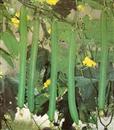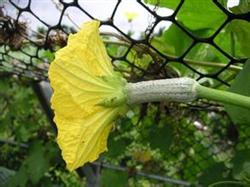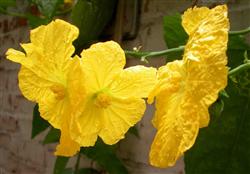Technical time of autumn planting of towel gourd

After the autumn towel gourd was sown from the middle and late July to the first and middle August, the growth and fruiting period was experiencing high temperature, Rain Water was less, and the autumn wind was rising. It is very easy to cause the seedling vine to grow slowly, the result is less, the disease and insect pests are more, the income is less. Therefore, attention should be paid to the cultivation and management: first, to cultivate strong seedlings and to protect the whole seedlings (1) seed selection. Choose towel gourd varieties with early maturity, suitable for close planting, disease resistance, high yield, aging resistance, good commercial properties, high early yield and long stick shape. (2) seed treatment. Soak the seeds in 30 ℃ warm water for 3 hours, soak them in 0.1% potassium permanganate solution for 30 minutes and disinfect them, then rinse them with clean water, germinate naturally under ventilated conditions, and sow the seeds after whitening. (3) sowing and seedling management. To raise seedlings in a nutrition cup, mix the ripe soil and a small amount of high-quality chicken shit evenly, put it in the cup, drench it with water, sow 2 germinated seeds in each cup, cover a small amount of fine soil, and spray with 1000 times of dimethazone solution. Then use a cover to cover the seedbed to prevent the scorching sun and heavy rain. During the seedling period, we should pay attention to keep the seedling soil moist, but not too much water, so as not to cause excessive growth. Seven days before transplanting, 2% potassium dihydrogen phosphate was sprayed twice to promote dark green leaves, strong stems and well-developed roots. Second, planting and field management (1) soil preparation and fertilization. Ten days before planting, 1500 kilograms of human rotten chicken, duck and pig manure, 100kg cake fertilizer and 50kg ternary compound fertilizer were applied per mu as base fertilizer. (2) colonization. When melon seedlings reach 4 Mel 4.5 leaves, it is time to plant them in the field. Using close planting cultivation, 2 meters open box, 2 rows per box, plant spacing 25-30cm, planting 2200 Mel 2500 plants per mu. (3) setting up a frame and pruning. Towel gourd is a climbing plant, it is necessary to build a flat shed before drawing vines, such as using bamboo poles, that is, after each oblique rod and a group of opposite poles in the box are erected into an oblique frame of about 2 meters high, the top of the rack is then pulled into a net with bamboo pole or plastic ribbon or iron wire respectively, and the towel gourd is introduced into the vine in time after releasing the vine, and the vine is tied up to assist in the shelf, so that its vine leaves are evenly distributed on the shelf. The lateral vines before the shelves should all be removed, and the lateral vines on the shelves should be removed in time when there are 2 Murray and 3 buds; and cut off too many male flowers, then leave 2 lateral vines at the upper end of the main vines, and the rest should be removed, when the 2 vines grow to about 10 leaves, and pay attention to erase the lower part of the old leaves of the main vines to reduce nutrient consumption and ensure ventilation and light in the field. In addition, we should also often manage melons, so that melons re-hang in the shed to grow, plant adjustment work, suitable for sunny afternoon to avoid damage to vine leaves. (4) Fertilizer and water management. When the first female flower pollinates and sets fruit, holes are opened about 30 cm from both sides of the root, 20 kg urea per mu, 50 kg cake fertilizer soaked for more than 3 days, and 25 kg ternary compound fertilizer as fruit fertilizer to promote melon and fruit expansion. After the first batch of melons were harvested, 15 kg of urea per mu was applied as relay fertilizer, and potassium dihydrogen phosphate, Yemanbao and other nutrient solutions were sprayed outside the roots while spraying to prevent diseases and insect pests. During the full fruiting period, the feces were harvested twice every 7 days, and 100 grams of urea could be added to every 50 kg of feces and urine. If abnormal fruits are found, they should be watered in time to keep the soil moist so as to prevent the increase of abnormal fruits caused by rain after drought and affect commodity benefits. Third, harvest in batches in due course. Towel gourd is eaten as tender gourd, so the harvest time is less elastic, generally 10 days from flowering to commercial melon ripening. In production, the fruit stem is smooth, the fruit is slightly discolored, the hairs are reduced and the skin is soft. Tender gourd can be harvested when the fruit surface is glossy. If not harvested in time, not only towel gourd fiber aging, loss of edible value, but also affect the late fruit setting. When picking fruit, it is better to cut the fruit stalk with scissors in the morning. Fourth, disease and pest control. The main diseases of towel gourd are virus disease, downy mildew and powdery mildew. Metalaxyl and triadimefon can be sprayed every 7 days for 3 times. Insect pests are mainly aphids, melons eliminate borer, skin guard melons, etc., prevention and control can use dimethoate 800x liquid, 5% card dead gram 1000 times liquid spray.
- Prev

Key technical points of towel gourd thinning and beard removal
The reasonable male thinning and whisker removal of towel gourd can reduce the unnecessary consumption of nutrients in soil and plant, make it concentrate on fruit growth and development, and thus increase the yield per unit area. The experiment showed that under the condition of the same cultivation and management, the setting rate per plant of towel gourd was higher than that of towel gourd without male thinning and beard removal.
- Next

There are many prevention and control methods for the causes of towel gourd rotten flowers.
The ratio of dipping anther: dipping flower medicament is generally based on Zugualing, naphthylacetic acid, 2pyrrolidine D, and then dipped in flowers with appropriate amount of nutrient solution and agents for prevention and control of Botrytis cinerea, the effect is very ideal. Smoke method to control rotten flowers: smoking method is a method to control towel gourd rotten flowers. Rotten flowers usually occur 3-4 days after dipping.
Related
- Where is it suitable to grow horseradish in China? it is expected to see the middle altitude horseradish in Alishan.
- How to prevent tomato virus disease reasonably? (Control methods included)
- Many people like to plant towel gourd on the balcony. What are the main points of this method and management?
- What crops can chili peppers be mixed with?
- Fertilization techniques and matters needing attention in Tomato
- What are the grafting techniques for peach seedlings in spring?
- Harm and control methods of root swelling disease of Chinese cabbage
- What are the pests of sweet potatoes? How to prevent and cure it?
- Symptoms, causes and Control methods of navel Rot in Tomato
- The cause of "Cucumber rotten bibcock" in Farmers' planting Cucumber and its Control Plan

